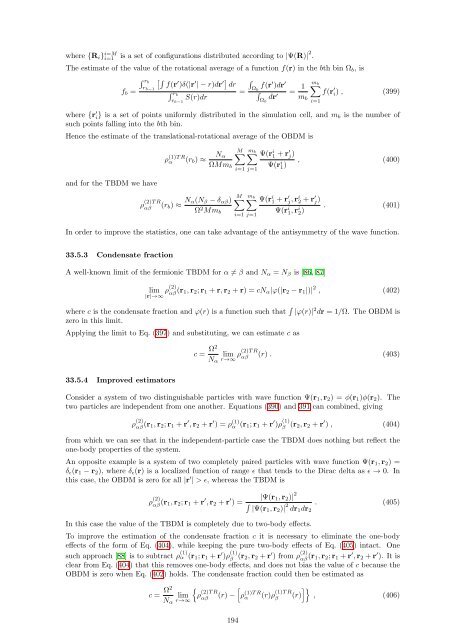CASINO manual - Theory of Condensed Matter
CASINO manual - Theory of Condensed Matter
CASINO manual - Theory of Condensed Matter
Create successful ePaper yourself
Turn your PDF publications into a flip-book with our unique Google optimized e-Paper software.
where {R i } i=M<br />
i=1 is a set <strong>of</strong> configurations distributed according to |Ψ(R)| 2 .<br />
The estimate <strong>of</strong> the value <strong>of</strong> the rotational average <strong>of</strong> a function f(r) in the bth bin Ω b , is<br />
∫ rb<br />
[∫<br />
r<br />
f b =<br />
b−1<br />
f(r ′ )δ(|r ′ | − r)dr ′] ∫<br />
dr<br />
Ω<br />
∫ rb<br />
= b<br />
f(r ′ )dr ′<br />
∫ = 1 ∑m b<br />
f(r ′<br />
r b−1<br />
S(r)dr<br />
Ω b<br />
dr ′ m<br />
i) , (399)<br />
b<br />
where {r ′ i } is a set <strong>of</strong> points uniformly distributed in the simulation cell, and m b is the number <strong>of</strong><br />
such points falling into the bth bin.<br />
Hence the estimate <strong>of</strong> the translational-rotational average <strong>of</strong> the OBDM is<br />
and for the TBDM we have<br />
ρ (1)T R<br />
α (r b ) ≈ N α<br />
ΩMm b<br />
ρ (2)T R<br />
αβ<br />
(r b ) ≈ N α(N β − δ αβ )<br />
Ω 2 Mm b<br />
∑<br />
∑<br />
M m b<br />
i=1 j=1<br />
∑<br />
∑<br />
M m b<br />
i=1 j=1<br />
i=1<br />
Ψ(r i 1 + r ′ j )<br />
Ψ(r i 1 ) , (400)<br />
Ψ(r i 1 + r ′ j , ri 2 + r ′ j )<br />
Ψ(r i 1 , ri 2 ) . (401)<br />
In order to improve the statistics, one can take advantage <strong>of</strong> the antisymmetry <strong>of</strong> the wave function.<br />
33.5.3 Condensate fraction<br />
A well-known limit <strong>of</strong> the fermionic TBDM for α ≠ β and N α = N β is [86, 87]<br />
lim<br />
|r|→∞ ρ(2) αβ (r 1, r 2 ; r 1 + r, r 2 + r) = cN α |ϕ(|r 2 − r 1 |)| 2 , (402)<br />
where c is the condensate fraction and ϕ(r) is a function such that ∫ |ϕ(r)| 2 dr = 1/Ω. The OBDM is<br />
zero in this limit.<br />
Applying the limit to Eq. (397) and substituting, we can estimate c as<br />
c = Ω2<br />
lim<br />
N α r→∞ ρ(2)T R<br />
αβ<br />
(r) . (403)<br />
33.5.4 Improved estimators<br />
Consider a system <strong>of</strong> two distinguishable particles with wave function Ψ(r 1 , r 2 ) = φ(r 1 )φ(r 2 ). The<br />
two particles are independent from one another. Equations (390) and 391 can combined, giving<br />
ρ (2)<br />
αβ (r 1, r 2 ; r 1 + r ′ , r 2 + r ′ ) = ρ (1)<br />
α (r 1 ; r 1 + r ′ )ρ (1)<br />
β (r 2, r 2 + r ′ ) , (404)<br />
from which we can see that in the independent-particle case the TBDM does nothing but reflect the<br />
one-body properties <strong>of</strong> the system.<br />
An opposite example is a system <strong>of</strong> two completely paired particles with wave function Ψ(r 1 , r 2 ) =<br />
δ ɛ (r 1 − r 2 ), where δ ɛ (r) is a localized function <strong>of</strong> range ɛ that tends to the Dirac delta as ɛ → 0. In<br />
this case, the OBDM is zero for all |r ′ | > ɛ, whereas the TBDM is<br />
ρ (2)<br />
αβ (r 1, r 2 ; r 1 + r ′ , r 2 + r ′ |Ψ(r 1 , r 2 )| 2<br />
) = ∫<br />
|Ψ(r1 , r 2 )| 2 . (405)<br />
dr 1 dr 2<br />
In this case the value <strong>of</strong> the TBDM is completely due to two-body effects.<br />
To improve the estimation <strong>of</strong> the condensate fraction c it is necessary to eliminate the one-body<br />
effects <strong>of</strong> the form <strong>of</strong> Eq. (404), while keeping the pure two-body effects <strong>of</strong> Eq. (405) intact. One<br />
such approach [88] is to subtract ρ (1)<br />
α (r 1 ; r 1 + r ′ )ρ (1)<br />
β (r 2, r 2 + r ′ ) from ρ (2)<br />
αβ (r 1, r 2 ; r 1 + r ′ , r 2 + r ′ ). It is<br />
clear from Eq. (404) that this removes one-body effects, and does not bias the value <strong>of</strong> c because the<br />
OBDM is zero when Eq. (402) holds. The condensate fraction could then be estimated as<br />
c = Ω2<br />
N α<br />
{<br />
lim<br />
r→∞<br />
ρ (2)T R<br />
αβ<br />
[<br />
(r) −<br />
194<br />
ρ (1)T R<br />
α<br />
]}<br />
(r)ρ (1)T R<br />
β<br />
(r) , (406)

















